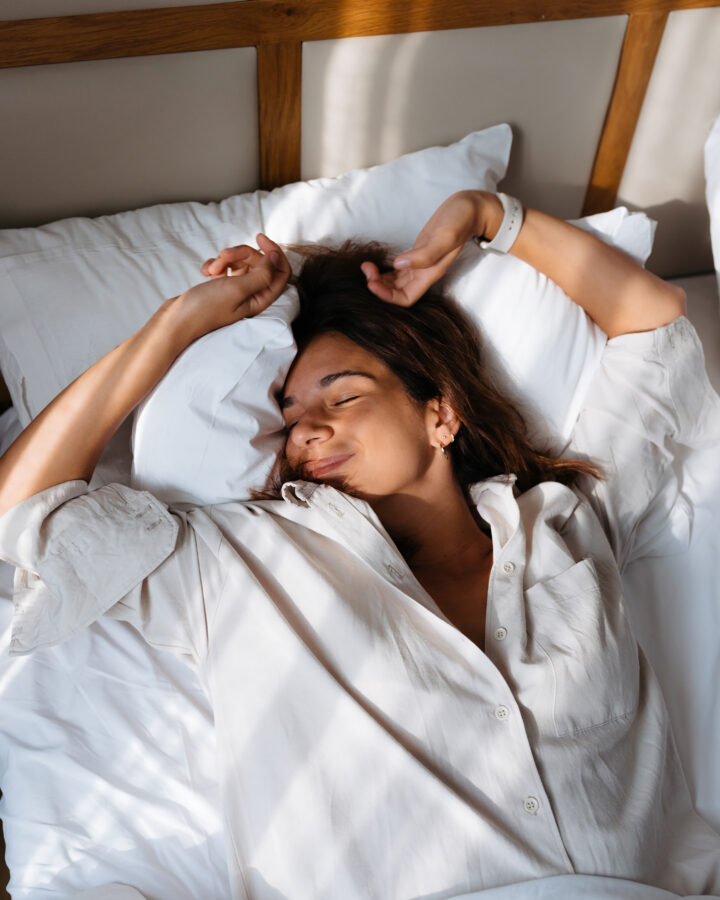The Longevity Sleep Routine for Deeper, Stronger Rest

A research-backed guide to improving sleep quality by working with your biology.
Sleep is your most important active repair ritual. Sleep sharpens cognition, regulates metabolism, preserves muscle, strengthens immunity, and supports emotional steadiness. In [lon-jev-i-tee]nounLiving a long life; influenced by genetics, environment, and lifestyle.Learn More research, sleep consistently emerges as one of the most powerful predictors of long-term health, independent of diet, supplements, or VO₂ max.
The good news: your daily rhythm can shift your biology toward deeper, higher-quality sleep. Below is a modern, longevity-focused routine built on the latest sleep science and designed to fit how real people live.
The Longevity Sleep Routine
Better sleep begins the moment you wake up. When your days take on a supportive rhythm, your nights follow naturally. This routine gathers the most impactful behaviors from modern sleep research into a sequence you can actually live with. Small shifts in timing, light, temperature, and wind-down rituals stack together to help your body settle, repair, and wake restored.
In the Morning:
- Get Natural Light Within 30–60 Minutes of Waking
If you do nothing else for your sleep, get morning sunlight. It’s the simplest and most potent circadian intervention we have. Morning light is your circadian anchor, and even 10–20 minutes early in the day can shift your sleep in meaningful ways. It improves sleep timing and regularity, helps you wake up feeling more refreshed, and stabilizes both mood and metabolic rhythms.
- Move Your Body Early in the Day
Regular morning exercise is linked to better sleep quality and healthier circadian regulation, primarily through its effect on decreasing morning [kawr-tuh-sawl]nounA hormone that helps manage stress, energy, and alertness.Learn More spikes. If your goal is to optimize sleep, morning movement may offer a modest but meaningful advantage over exercising later in the day.
- Eat a Protein-Forward Breakfast
Eat breakfast within two hours of waking. Early meals activate clock genes, improve [in-suh-lin sen-si-tiv-i-tee]nounHow effectively your body uses insulin, which regulates blood sugar levelsLearn More, and sync your peripheral clocks (in the liver, gut, muscle, and adipose tissue) to the daytime phase. That alignment helps protect the nighttime “rest-and-repair” window, reduces late-night hunger, and stabilizes glucose so your sleep isn’t disrupted by evening spikes. Choose a protein-forward meal (20–30g) to amplify satiety and support steady energy through the day.
In the Afternoon
- Cut Off Caffeine
Caffeine has a much longer tail than most people realize. In a controlled study testing the same 400 mg dose at bedtime, 3 hours before bed, and even 6 hours before bed, every timing disrupted sleep. Even the 6-hour dose shrunk total sleep time by more than an hour and increased nighttime awakenings. Stop caffeine at least 6 hours before lights-out, and if you’re sensitive, aim for 8–10 hours.
- Stay Hydrated Through the Day
Hydration may influence your sleep architecture. In a 2025 crossover study using continuous sleep tracking, higher daily fluid intake was linked to longer REM sleep, longer total sleep time, and better sleep efficiency, even when mild dehydration didn’t show obvious effects. The takeaway: front-load water during the day, taper at night, and aim for steady hydration to support deeper, more restorative REM cycles.
Three Hours Before Bed
- Finish Dinner Three Hours Before Bed
Your metabolism runs on a circadian schedule, and late meals push that clock in the wrong direction. In a rigorous randomized crossover trial published in Cell Metabolism, researchers found that eating later in the evening increased hunger signals, lowered energy expenditure, reduced core body temperature, and shifted adipose gene expression toward greater fat storage. These physiological changes are tied to lighter, more fragmented sleep and reduced slow-wave sleep. If you need a snack, choose a small, protein-forward option to avoid glucose spikes.
90 Minutes Before Bed
- Take a Warm Bath or Shower
A warm bath around in 104°F water, mid-chest level, for 15–20 minutes raises core body temperature by roughly 1.5–2°F, allowing for a strong cooling drop before sleep. In one study, that bigger “heat up, then cool down” curve helped people fall asleep faster, wake less in the night, and rate both sleep onset and sleep quality higher. Aim to finish your soak 60–90 minutes before lights out, then let your body cool naturally as you wind down.
- Dim Lights and Reduce Blue Light
Even ordinary evening lighting from overhead room lights pushes melatonin onset back by about 90 minutes and suppresses presleep levels by more than 70%. That means your brain gets a weaker “nighttime” signal. The fix is simple: switch to dim, warm light in the hour or two before bed. Think lamps, low wattage, nighttime blue blocker glasses, or amber bulbs. Protecting darkness protects your sleep.
- Go Screen-Free
Evening screen exposure delays your brain’s “night mode.” Tablets and phones held close to the eyes and rich in blue wavelengths suppress pre-sleep melatonin, increasing alertness and making it harder to nod off. The simplest fix: power down screens 60–90 minutes before bed. If you must use them, switch to warm, dim settings, drop brightness below 30%, and use blue-blocking glasses to protect melatonin and preserve sleep timing.
60 Minutes Before Bed
- Practice [yoh-guh nee-drah]nounA deep relaxation practice often referred to as yogic sleep.Learn More
Yoga Nidra is a guided, non-sleep deep rest practice that reliably shifts the nervous system into a calmer, more parasympathetic state. In clinical trials with adults experiencing insomnia, regular Yoga Nidra reduced nighttime wakefulness, increased restorative sleep, and lowered evening cortisol, all signs of a body easing into deeper rest. Press play on a 20–30 minute recording in the hour before bed, lie down, and let your breath slow as your system downshifts toward sleep.
- Cool the Room
Temperature is one of the most powerful and overlooked drivers of sleep continuity. Your core body temp needs to drop at night, and a cool bedroom helps that happen. In a massive study analyzing over 3.75 million nights of sleep, every 1°F increase in bedroom temperature between 60–85°F was linked to poorer sleep: lower sleep efficiency, shorter total sleep time, longer time to fall asleep, and more nighttime wakefulness. Aim for 65–68°F, keep bedding light, and use fans or cooling devices if needed.
- Regulate Your Soundscape
Sound is one of the most common sleep disruptors. Sudden noise can activate your brain’s threat-detection networks, fragmenting sleep even if you don’t fully wake up. A recent study in Sleep Medicine, found that [whyte noyze]nounSteady background noise that aids in sleep and focus.Learn More can improve sleep quality, particularly in adults, by reducing nighttime wakings. While other studies in college-age
Lights Out
- Sleep in Complete Darkness
A single night of moderate room light (about the brightness of a hallway or bedside lamp), keeps the body in a low-grade “alert” state while you sleep. In a controlled clinical study, this level of light raised nighttime heart rate, reduced heart rate variability, pushed people into lighter sleep, and even impaired next-morning insulin sensitivity. The mechanism wasn’t melatonin suppression but sympathetic activation: your body stays switched on when it should be powering down. The fix is simple: sleep in total darkness. Use blackout curtains or a sleep mask, cover LEDs, and dim your environment.
- Keep Consistent Timing
Regular sleep timing doesn’t just support longevity, it directly improves rest quality. Studies show that consistent bed and wake times lead to deeper slow-wave sleep, more consolidated REM, and fewer nighttime awakenings. Even when you sleep the same number of hours, shifting your bedtime or wake time by an hour or two scrambles your circadian system. The simple rule is to keep your lights-out and wake times steady.
Try This Micropractice Tonight
Choose one thing from this list and make it a ritual.
- A warm shower 90-minutes before bed.
- A screen-free final hour.
- A completely dark room.
- A cooler bedroom.
- A consistent lights-out routine.
Small rhythms shift long-term biology.
Read This Next
The information provided in this article is for educational and informational purposes only and is not intended as health, medical, or financial advice. Do not use this information to diagnose or treat any health condition. Always consult a qualified healthcare provider regarding any questions you may have about a medical condition or health objectives. Read our disclaimers.

